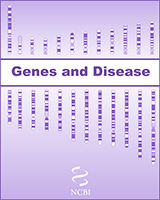NCBI Bookshelf. A service of the National Library of Medicine, National Institutes of Health.
National Center for Biotechnology Information (US). Genes and Disease [Internet]. Bethesda (MD): National Center for Biotechnology Information (US); 1998-.
Multiple endocrine neoplasia (MEN) is a group of rare diseases caused by genetic defects that lead to hyperplasia (abnormal multiplication or increase in the number of normal cells in normal arrangement in a tissue) and hyperfunction (excessive functioning) of two or more components of the endocrine system.
Endocrine glands are different from other organs in the body because they release hormones into the bloodstream. Hormones are powerful chemicals that travel through the blood, controlling and instructing the functions of various organs. Normally, the hormones released by endocrine glands are carefully balanced to met the body's needs. When a person has MEN, specific endocrine glands, such as the parathyroid glands, the pancreas gland, and the pituitary gland, tend to become overactive. When these glands go into overdrive, the result can be: excessive calcium in the bloodstream (resulting in kidney stones or kidney damage); fatigue; weakness; muscle or bone pain; constipation; indigestion; and thinning of bones.
The MEN1 gene, which has been known for several years to be found on chromosome 11, was more finely mapped in 1997.
Related diseases
- Genome view see gene locations
- Entrez Gene collection of gene-related information
- BLink related sequences in different organisms
- Research articles online full text
- Books online books section
- OMIM catalog of human genes and disorders
- MEN1 and MEN2 in GeneReviews
- Fact sheet from the National Institute of Diabetes and Digestive and Kidney Diseases, NIH
- Multiple endocrine neoplasia - Genes and DiseaseMultiple endocrine neoplasia - Genes and Disease
Your browsing activity is empty.
Activity recording is turned off.
See more...
